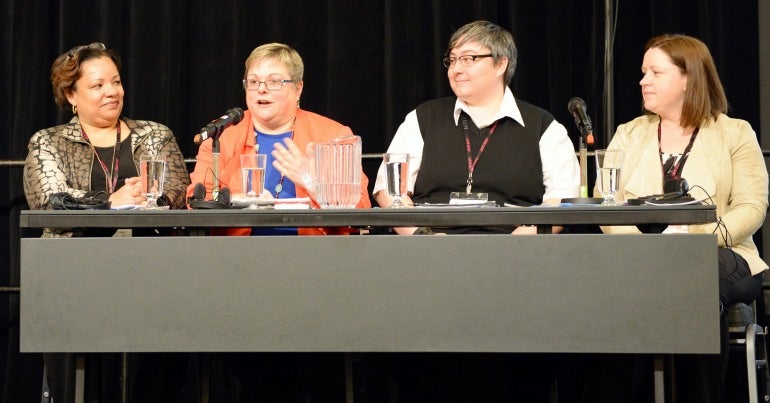Tips for building strength by empowering your local’s most vulnerable members
- Reach out to precariously employed workers. Include them in union education and training, and invite them personally to general membership meetings.
- Hold small group meetings between elected local leaders and specific classifications, occupational groups, shift workers and precariously employed workers to discuss issues they care about.
- Ensure there is representation from precariously employed workers on the bargaining committee. If needed, form a sub-committee to address the issues specific to vulnerable workers.
- Tackle precarity in bargaining by fighting for access to benefits and pension entitlements and language that obligates the employer to convert part-time position to full-time, permanent positions.
- Provide mentoring opportunities to nurture and educate the next generation of local union leaders – especially under-represented groups including equity-seekers, precariously employed members and young workers.
- Encourage precariously employed workers to run for executive positions. Consider designating one executive position specifically to represent precarious workers.
Try and try again: precariously employed workers, by the very nature of their work lives, are prone to anxiety and feelings of abandonment. It may take more than one try to get someone involved.
Kate Procopio didn’t plan on becoming a union activist. The CUPE 23 member has been a precariously employed auxiliary worker for the City of Burnaby, BC, for 19 years. And she had more or less resigned herself to the vagaries of auxiliary work, until things at work started changing.
CUPE 23 has about 2,400 members, 1600 of whom are auxiliary. When part time and temporary full-time workers are counted, nearly 65% of the local is precarious employed. A worker in a precarious job has no set or consistent work schedule, no job security, no benefits, sick days or pension and often no vacation. They are expected to be ready and available for work even though the employer makes no reciprocal guarantee that they will be given a shift. They often have shifts cancelled shortly before their start, with no compensation.
“This creates a culture where workers in precarious jobs are seen as ‘second class citizens’ who don’t count when it comes to ethical treatment,” Kate says. “And to add insult to injury, those workers often feel disconnected from and abandoned by their union. Shift work, unpredictable schedules and second or third jobs make it very difficult to attend meetings.”
Kate’s activism was sparked by changes at work that upset her and her co-workers and raised concerns about what that could mean for their paycheques.
“And to top it off,” Kate says, “we didn’t have a shop steward at our site. I stepped into the role because, even though my position is precarious, it was more stable than others and I was less likely to suffer repercussions for speaking up.”
At the training for new stewards, Kate was approached by facilitators from the local who encouraged her to come to a general membership meeting. Even though she didn’t think her interest in the union was going to extend much beyond her role as a steward, Kate accepted the invitation and attended the next meeting. There she was encouraged to join the newly formed precarious workers committee.
During the next round of contract negotiations, however, Kate found that she was going to have to engage even more deeply with the union if she wanted fair treatment for her fellow precariously employed workmates. The bargaining committee sent a survey out to all members asking about auxiliary issues and seemed to be taking them seriously. “I was busy cheerfully spreading the word about hope and the changes that would come for us in the new collective agreement, but when it finally arrived, I was stunned. There was virtually nothing in it for us.”
Auxiliaries and part-timers felt let down and sold out. Members of the precarious worker committee were crushed. “We felt useless, as if the formation of the committee was just for show. All we saw was a lack of concern paid to our issues, while the full-timers increased their benefits. It created a hugely divisive climate, which endangers a union’s greatest strength: solidarity.”
But the committee took their feelings of anger and disappointment and made a plan to prevent the same thing from happening in the next round of bargaining. They worked towards having auxiliary workers on the executive and bargaining committee. Meanwhile, the local executive put pressure on the employer about auxiliary issues and got legal advice on how to enforce the existing protective contract language for precarious workers.
It took time, but the local continues to make progress. There are now two precariously employed workers on the executive, one of whom is Kate. “We are making progress, but it is not a simple job. The relationship with precarious workers needs constant tending because precariously employed workers are, by the nature of their status, prone to anxiety, feelings of abandonment and persecution,” Kate concludes. “But it’s because of this that the union as a whole must rally around precarious workers. We are your most vulnerable members, and if we are kept weak, then the local cannot truly be strong.”



